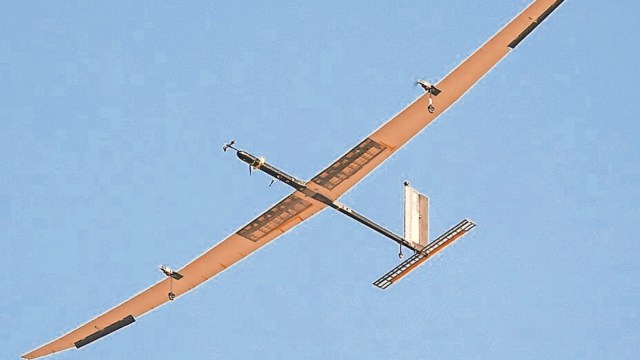Meet HAPS: India’s very own UAV that can fly 20 km high and float for months
HAPS is a still-developing technology, and the successful test flight last week puts India among a very small group of countries currently experimenting with this technology.
 First test flight of a prototype was conducted last week. NAL
First test flight of a prototype was conducted last week. NALTHE NATIONAL Aerospace Laboratories (NAL) in Bengaluru has successfully completed the first test of a solar-powered “pseudo satellite”, a new age unmanned aerial vehicle (UAV) that can significantly increase India’s surveillance and monitoring capabilities in the border areas.
The high-altitude pseudo satellite vehicle, or HAPS, can fly at altitudes of 18-20 km from the ground, almost double the heights attained by commercial airplanes, and, thanks to its ability to generate solar power, can remain in air for months, even years, offering it advantages of a satellite. But because it does not require a rocket to get into space, the cost of operating HAPS is several times lower than that of a satellite that is usually placed at least 200 km from the earth.
HAPS is a still-developing technology, and the successful test flight last week puts India among a very small group of countries currently experimenting with this technology.
The test flight, carried out in the Challakere testing range in Chitradurga district of Karnataka, saw the scaled-down 23-kg prototype with a wing-span of about 12 metres, remain in air for about eight and a half hours, achieving an altitude of about 3 km from the ground.
“This is a very important milestone in the development of HAPS. But there are a few more milestones to be attained before HAPS is ready for industrial production. The next step, and we hope to do it next month itself, is to make this vehicle fly for at least 24 hours, during which the entire sequence of power generation, involving the solar cells and batteries that would be charged during the day and consumed during the night, can be tested. We are working towards a deployment target by 2027,” Abhay Anant Pashilkar, director of NAL, one of the laboratories under the Council of Scientific and Industrial Research (CSIR), told The Indian Express.
The need for development of high-endurance, high-altitude flying instruments arose from the desire to have continuous surveillance of border areas to detect changes or movements, particularly in the wake of the Doklam standoff in 2017. Battery-powered UAVs can remain in air for a limited period of time and can scan relatively smaller areas. Satellites placed in low-earth orbits and meant to observe the Earth usually move in their orbits and are not watching constantly.
Solar-powered unmanned aircraft is considered a better solution. Although NASA has been using solar-powered engines for its Pathfinder series of aircraft for a long time, it is only now that other countries have got into developing more sturdy and nimble versions of solar aircraft for a variety of purposes. China, South Korea, and the UK are some of the other countries where this development is taking place. Some private companies are also developing HAPS, even in India.
In December last year, Bengaluru-based NewSpace Research and Technologies, a deep-tech start-up, flew a similar solar-powered UAV, having developed the technology through the Innovation of Defence Excellence initiative of the Defence Ministry.
The test flight by NAL was the result of a separate initiative of R&D in this area started by CSIR.
“HAPS can be very useful in disaster situations as well. It can even be used to provide mobile communications networks in remote areas, if the normal networks get damaged due to any calamity. A lot of other things that satellites are deployed to do can be done by these vehicles,” Pashilkar said.
NAL will only develop the technology and a prototype. The manufacturing of the actual thing would happen with industry linkages. The aircraft that was successfully tested was a scaled-down version, one-third in size to the eventual aircraft.







